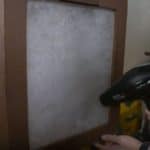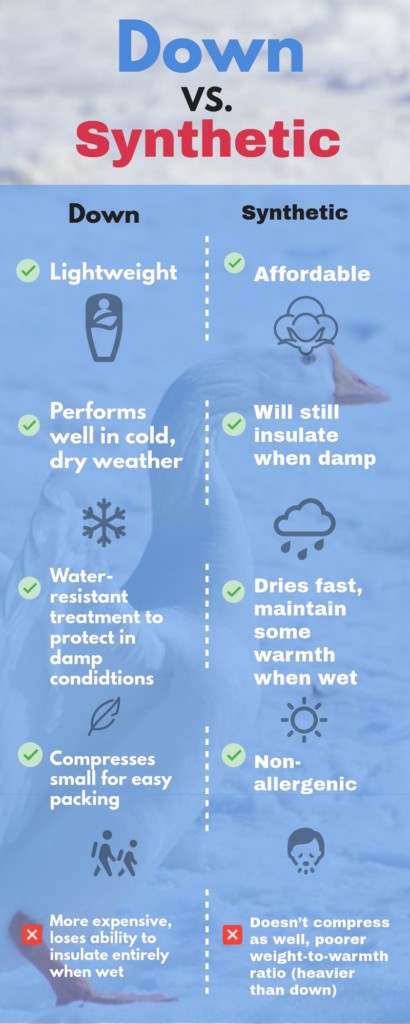Most camping, hiking, and outdoor enthusiast agree that down is the best fill material for a sleeping bag. What makes it so unique is down is incredibly insulating and has a great warmth to weight ratio. Ounce for ounce, down is the warmest insulating material available. While synthetic fill has its place down is fantastic in dry, cold environments. Synthetic fill does have it’s place, if your looking for a sleeping bag and your price-sensitive synthetic is worth a look.
We have a full break down of Down vs. Synthetic if you what to see the differences.
What is Down
The down of birds is a layer of fine feathers found under the tougher exterior feathers. Very young birds are not only adorable but are covered only in down. There are a few types of down, but the down in a sleeping bag or down jacket is going to be duck or goose.
Duck down is cheaper and in places like China, where duck is consumed more than the US ducks are plentiful. Goose down is better than duck because the down cluster is more significant and has more loft. Since lofty down is warmer down, it’s going to be one of the vital deciding factors of your choice of sleeping bags. This is measured in fill power.
Down Fill Power
Fill power is a measure of the loft or fluffiness of a down product that is related to the insulating value of the down. The higher the fill power, the more air a specific weight of the down can trap. So the higher the fill power number, the more warmth your sleeping bag will trap in. So a lighter bag with high fill power can be as warm as a heaver bag with a lower fill power.
When looking at sleeping bag fill power, remember that’s not telling you the temperature rating of the bag, just the fill power. This was something I was a little confused about when first looking into sleeping bags. Many factors go into temperature rating, and a sleeping bag with a lower fill power can have a higher rating if there’s more down inside the bag (heavier bag).
How do They Measure Fill Power
In a controlled environment, a technician receives the sample from a source and puts it in a fill-power box. They steam clean the fill on all sides of the box until the down is completely saturated. Then, they will use a dryer on the fill until it’s completely dry. This allows the down to return to its original state, nice and fluffy.
They then take 28 grams, or 1 ounce by hand and place it into a transparent cylinder. The cylinder is an industry-standard size used all around the world. Once the down has been set in place, a light plate is placed on top, compressing the down naturally (not forced). When the plate stops, the measurement is taken, the volume below the weight indicates the fill power.
As an example, a result of 550 cubic inches of down equates to 550 fill power down. Down insulation is rated by fill power, which is the number of cubic inches displaced by a given ounce of down.
How to Choose High-Quality Down
Not all down sleeping bags are created equal. There are many factors when searching for the right sleeping bag, but let’s look at the down right now. Down insulation in most sleeping bags range from about 400 to 900. Down rated 500–650 is warm enough and light enough for most conditions, and 800–900 fill is used for very lightweight and very cold-weather gear. Even down with a fill power as low as 500 still provides reasonably good insulation and better than synthetic fill at the same weight.
As an example, let’s look at the Western Mountaineering Bison (Amazon link). It has 850+ power goose down fill. On the other end of the scale, we have the KingCamp Down Mummy down sleeping bag (Amazon link) with 500 duck down fill. The Western Mountaineering sleeping bag is filled with 42 oz of down fill, while the KingCamp has 14 oz of down fill.
The most exciting thing about comparing these two is the bag weight, 4 lbs. 10 oz for the Bison, and 3.6 lbs (2.2 lbs for mummy) for the KingCamp. The Bison is slightly heavier and is rated at -40° degree F while the KingCamp is rated for 37.4 Degree F. Since higher fill-power downs will insulate better than lower fill-power downs, the Western Mountaineering Bison sleeping bag in this example is going to be a beast of a bag.


I know this comparison is extreme, and the bags serve different purposes, but I wanted to illustrate the power of down. While looking the same at almost the same weight their performance differs greatly.
Down Sleeping Bags Compact to a Small Size
Using a compression sack while backpacking can save space inside your backpack. The size of the sack, when compressed all the way, will be much smaller with a down sleeping bag vs.a synthetic of the same temperature rating. A compression sack is going to push all the air out, forcing the down bag into a small space.
This is a nice benefit because you’ll be able to fit more gear into your hiking backpack. Another possible downside is allergic reactions to down that cause itchiness and other discomforts. What most people don’t realize is they are actually more likely allergic to dust mite feces, not the down feathers.
Dust mites thrive in moist environments like sleeping bags and pillows, which become moist due to our perspiration. A great hack I’ve come across is heating the sleeping bag in your dryer – to at least 135F – for a minimum of 15 minutes, killing the dust mites.
The Downsides
Being exposed to wetness and moisture is the biggest downside. When your down sleeping bag gets wet, it’s almost useless in traping in your body heat. When down gets wet, it becomes a saturated, clumpy mess.
This is a big concern if you’re in an area where it’s challenging to keep your pack dry. For the benefits of down and synthetics, there are now hydrophobic down sleeping bags. When the down gets wet, it will still maintain its loft, keeping you warm. With this treatment, it’s oftentimes better than standard down for a moist or damp environment.
Another possible downside is allergic reactions to down that cause itchiness and other discomforts. What most people don’t realize is they are actually more likely allergic to dust mite feces, not the down feathers. Dust mites thrive in moist environments like sleeping bags and pillows, which become moist due to our perspiration.
A great hack I’ve come across is heating the sleeping bag in your dryer – to at least 135F – for a minimum of 15 minutes, killing the dust mites.
Down Ethical Standards
Down is a byproduct of the food industry. Live plucking of birds is illegal in the United States and Europe. The Responsible Down Standard label certifies that the down in sleeping bags and other gear that has down and feathers in them came from birds that were treated well.
The Responsible Down Standard goal to ensure that down and feathers come from animals that have not been subjected to unnecessary harm. When choosing a sleeping bag, ask for the manufacture for the RDS certification. You can find more information here, Responsible down here.
Is there any argument for live plucking of geese? The only ones I’ve found have been, so the geese don’t die; these fine down clusters grow back larger making a higher fill power. Stick to RDS certified though to sleep easier.
Temperature Ratings
No matter what type of fill you choose for your sleeping bag, make sure to look at the ISO rating for the temperature rating on the bag. This rating represents lap tested temperature results for all brands. Do note that these ratings are for adults only, and there’s no rating and testing for children and babies.
Comfort rating: This indicates the lower limit of the comfort range, down to which a sleeping bag user with a relaxed posture, such as lying on their back, is globally in thermal equilibrium and just not feeling cold.
Limit temperature: Lower limit at which a sleeping bag user with a curled up body posture is globally in thermal equilibrium and just not feeling cold.
Extreme temperature: The very low temperature where the risk of health damage by hypothermia is possible.
| Bag Type | Temperature Rating (°F) |
|---|---|
| Summer Bags | +35° and higher |
| 3-Season Bags | +15° to +30° |
| Winter Bags | +15° and lower |
Combine With the Right Sleeping Pad for More Warmth
A sleeping bag and sleeping pad work together. The pad is a crucial part of the pair because a sleeping bag alone won’t provide enough insulation. You’ll still be cold with a high-quality, high fill power sleeping bag on the cold ground. You’ll need to match the right sleeping pad for your style of hiking. Thankfully a high-quality pad will be significantly cheaper than a great sleeping bag.
There are a few different types of sleeping pads, and just like bags, you’ll choose from a balance of comfort, weight, and insulation. Manufacturers use R-Value to measure the pad’s ability to insulate you from the cold ground. It’s the measure of thermal resistance the pad has. The higher the R-Value, the more effective the sleeping pad is. I go into more detail about sleeping pads on the bottom of my article here.
If you have decided on fill, have a look at our guild on how to choose a sleeping bag here.






